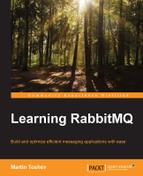Learning RabbitMQ provides you with a practical guide for the notorious message broker and covers the essentials required to start using it. The reader is able to build up knowledge along the way—starting from the very basics (such as what is RabbitMQ and what features does it provide) and reaching the point where more advanced topics, such as RabbitMQ troubleshooting and internals, are discussed. Best practices and important tips are provided in a variety of scenarios; some of them are related to external systems that provide integration with the message broker or that are integrated as part of the message broker in the form of a RabbitMQ plugin. Practical examples are also provided for most of these scenarios that can be applied in a broader context and used as a good starting point.
An example system called CSN (Corporate Social Network) is used to illustrate the various concepts provided throughout the chapters.
Each chapter ends with an Exercises section that allows the reader to test his understanding on the presented topic.
Chapter 1, Introducing RabbitMQ, provides you with a brief recap on enterprise messaging and a short overview of RabbitMQ along with its features. Other similar technologies are mentioned and an installation guide for the message broker is provided at the end of the chapter. The basic terminology behind RabbitMQ such as exchanges, queues, and bindings is introduced.
Chapter 2, Design Patterns with RabbitMQ, discusses what messaging patterns can be implemented using RabbitMQ, including point-to-point, publish-subscribe, request-reply, and message router types of communication. The patterns are implemented using the building blocks provided by the message broker and using the Java client API.
Chapter 3, Administration, Configuration and Management, reveals how to administer and configure RabbitMQ instances, how to install and manage RabbitMQ plugins, and how to use the various utilities provided as part of the RabbitMQ installation in order to accomplish a number of administrative tasks. A brief overview of the RabbitMQ management HTTP API is provided.
Chapter 4, Clustering, discusses what built-in clustering support is provided in the message broker and how it can be used to enable scalability in terms of message queues. A sample RabbitMQ cluster is created in order to demonstrate how nodes can be added/removed from a cluster and how RabbitMQ clients can connect to the cluster.
Chapter 5, High Availability, extends on the concepts of clustering by providing an overview of how a RabbitMQ cluster can be made more reliable in terms of mirrored queues and how messages can be replicated between remote instances using the Federation and Shovel plugins. High availability in terms of client connections and reliable delivery is also discussed with AMQP transactions, publisher confirms, and client reconnections.
Chapter 6, Integrations, provides you with a number of practical scenarios for integration of the message broker with the Spring framework, with ESB (enterprise services bus) systems such as MuleESB and WS02, and with database management systems (RDBMS and NoSQL). Deployment options for RabbitMQ using systems such as Puppet, Docker, and Vagrant are discussed in the chapter. A brief overview of how RabbitMQ applications can be tested using third-party frameworks is provided at the end of the chapter.
Chapter 7, Performance Monitoring and Tuning, gives a detailed list of factors that must be considered in terms of performance tuning of the message broker. The PerfTest tool is used to demonstrate how the RabbitMQ performance can be tested. At the end of the chapter, several monitoring solutions that provide support for RabbitMQ such as Nagios, Munin, and Monit are used to demonstrate how the message broker can be monitored in terms of stability and performance.
Chapter 8, Troubleshooting, illustrates a number of problems that can occur during the startup of the message broker and normal operation along with the various causes and resolutions in such cases. A brief primer on the Erlang programming language is provided for the purpose of understanding and analyzing the RabbitMQ crash dump—either directly or using the Crashdump Viewer for convenience.
Chapter 9, Security, provides a high-level overview of the vulnerability landscape related to the message broker along with a number of techniques to secure a RabbitMQ setup. Authentication, authorization, and secure communication are among the most important concepts covered in the chapter.
Chapter 10, Internals, discusses the internal architecture of the message broker and provides a detailed overview on the most important components that RabbitMQ comprises of.
Appendix A, Contributing to RabbitMQ, provides a short guide on how to get the RabbitMQ sources, how to set up a development environment, and how to build the message broker. A short discussion on how to contribute to the RabbitMQ ecosystem is provided as part of the appendix.
